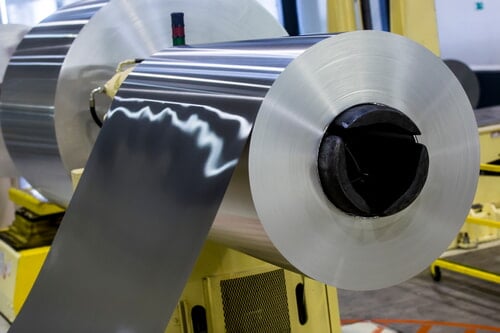Metalwork

Aluminum Production Industry
Aluminum is used to produce many products, including vehicles. This metal is highly versatile, recyclable, lightweight, and durable, and it resists corrosion. Because it is about a third of the weight of steel, many vehicle manufacturers use aluminum for blocks, heads, and even vehicle bodies. Other industries that use aluminum include construction, aircraft, consumer packaging, and aerospace. The aluminum production industry creates aluminum plates, sheets, and foils.
Operational Areas in the Aluminum Production Industry
The aluminum industry is divided into sub-industries with companies operating in different areas, including the following:
- Refining alumina.
- Creating aluminum from alumina.
- Purchasing and alloying aluminum.
- Recovering aluminum from scrap.
- Manufacturing bars, pipes, foil, rods, plates, tubes, sheets, and wire.
Aluminum-Forming Activities in the Aluminum Production
Once factories process aluminum, manufacturers use it to make products. Different types of companies process aluminum in different ways, including:
- Aluminum sheet, foil and plate manufacturing: The companies flat roll continuous plates, foil, sheets and welded tubes for aircraft, roofing, ships and other products.
- Aluminum extruded product manufacturing extrude aluminum base alloy and aluminum into basic shapes, such as pipes, rods and tubes. These products are used to create tubing, car bumpers and beams.
- Aluminum forgers pour molten aluminum into molds to create parts for engines, machinery and aircraft. Forging companies also create cast aluminum.
- Secondary smelters and aluminum alloying companies recover the aluminum from scrap, including cans, parts, roof panels, and other aluminum scraps.
- Factories also make products that use aluminum as a major ingredient. These companies include electronic equipment manufacturers, motorcycle equipment manufacturers and automotive equipment manufacturers. Some examples of the products they make including trays, beverage cans, bottles, packaging, helmets and tubes.
Occupations that Help Make Aluminum or Use Aluminum
Several occupations make or use aluminum to create products, including:
- Construction laborers.
- Computer-controlled machine operators.
- Extraction occupations.
- Electricians.
- Puncing, cutting and press machine setters.
- Extruders.
- Machine operators and tenders.
- Foundries, including mold and core makers.
- Production helpers.
- Industrial machinery mechanics and maintenance workers.
- Machinists.
- Material movers.
- Pourers and casters.
- Molders and molding machine setters.
- Rolling machines setters and operators.
- Plastic and metal workers.
- Metal-refining furnace operators.
- Metal furnace operators.
All of these occupations handle aluminum in some form, including molten aluminum. These occupations are more likely to need personal protective equipment than others. However, regardless of how “safe” the task at hand seems to be, you should always wear the proper personal protective equipment.
Common Injuries in the Aluminum Production Industry
Working with aluminum increases the risks of many injuries, depending on your job. Some of the common activities, injuries related to them, and the personal protective equipment needed to minimize the risk of injury include:
- Bending aluminum. The sharp edges of the aluminum product could cut workers’ hands. You can minimize this type of injury by wearing cut-resistant gloves. Abolox carries several types of cut-resistant gloves and puncture-resistant gloves that meet industry standards. Because the aluminum could easily cut your wrists and lower arms, it’s best to choose gloves that extend past your wrists.
- Working on mechanical systems puts you at risk for crush and impact injuries. Our impact gloves reduce the risk of these injuries.
- Cutting aluminum can also cause cuts because of the sharp edges. Even when the sharp edges are smoothed, they are still sharp enough to cut. Workers cutting aluminum should have several pairs of cut-resistant gloves on hand.
- Grinding aluminum also increases the risk of cuts and punctures. The best cut-resistant gloves have longer cuffs to protect your wrists and lower arms. Workers should also wear goggles and face protection to prevent aluminum slivers from becoming embedded in their skin and eyes.
- Depending on the job, aluminum workers might work with chemicals and flying fragments. Goggles provide more protection for this type of work than safety glasses. You can even wear goggles over your prescription glasses. Face shields add another layer of protection and keep sharp fragments and chemicals off your face.
- Visibility is an important part of safety. Some factories are not well-lit, or the lights are so high it doesn’t make a difference. Wearing hi-vis clothing ensures that moving material workers see each other and other employees.
- Aluminum sprayers need lined eyewear, waterproof gloves and protective clothing to prevent the chemicals from getting into their eyes and face and causing burns on other parts of the body.
Contact Abolox
We at Abolox carry all the personal protective equipment you need to stay safe in the aluminum production industry. You can buy many of our products in bulk if you are buying for your employees – or your employees can visit Abolox and order individual products. If you don’t see what you need, call the office, and we’ll source it for you.